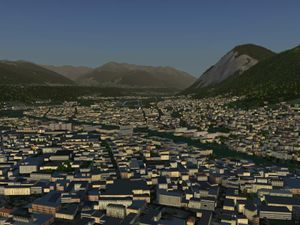Osm2city.py: Difference between revisions
No edit summary |
No edit summary |
||
| Line 3: | Line 3: | ||
== Overview == | == Overview == | ||
osm2city is a set of procedural programs, which create plausible FlightGear scenery objects (buildings, roads, power lines, piers, platforms etc.) based on OpenStreetMap (OSM) data. | ''osm2city'' is a set of procedural programs, which create plausible FlightGear scenery objects (buildings, roads, power lines, piers, platforms etc.) based on OpenStreetMap (OSM) data. | ||
* The development [https://gitlab.com/fg-radi/osm2city repository] is hosted on gitlab. | * The development [https://gitlab.com/fg-radi/osm2city repository] is hosted on gitlab. | ||
| Line 10: | Line 10: | ||
* Written in Python 3.5, developed on Linux. It should also run on Windows and Mac OSX, however most testing is done on Linux. | * Written in Python 3.5, developed on Linux. It should also run on Windows and Mac OSX, however most testing is done on Linux. | ||
== | == Programs and Feature Areas == | ||
* | ''osm2city'' contains the following programs to generate scenery objects based on OSM data: | ||
* '''buildings.py''': generates buildings honoring OSM height and level tags as well as reads relations ('buildings with holes'). Includes lightmaps, complex sloped roofs (using Olivier Teboul's implementation of the straight skeleton algorithm), obstruction lights on tall buildings. Texturing of roofs and facades based on a texture manager, which find matching texture for given building (number of levels, modern/old building, etc). | |||
* '''roads.py''': generates different types of roads and railways incl. texturing and automatically calculated bridges. | |||
* '''pylons.py''': generates pylons and cables between them for power lines, aerial ways, railway overhead lines as well as street-lamps, wind turbines and storage tanks. | |||
* '''piers.py''': generates piers and boats. | |||
* '''platforms.py''': generates railway platforms. | |||
All generated objects are added as static or shared objects to FlightGear scenery with correct elevation read on the fly from existing FlightGear scenery. Tagging and topology in OSM are respected as far as possible and complemented with some heuristics (given the developer team's origin mostly inspired by how stuff looks in Europe). | |||
:* | |||
* | |||
* | |||
== Planned Features == | == Planned Features == | ||
(in random order) | (in random order) | ||
* Rembrandt lighting | |||
* Rembrandt lighting | * put a piece of matching ground texture around buildings ('garden') | ||
* put a piece of matching ground texture around buildings ('garden') | * put shared models if/where OSM indicates so: gas stations... | ||
* put shared models if/where OSM indicates so: gas stations... | * place buildings at plausible places in areas, where OSM coverage is low | ||
* | * use region specific models for detached and row houses | ||
* performance improvements for generation and usage | |||
* | |||
* | |||
== Contributing == | == Contributing == | ||
Revision as of 07:57, 18 February 2017
| Started in | 11/2013 |
|---|---|
| Description | Improved autogen support for FlightGear using OSM data |
| Contributor(s) | radi, vanosten, Soitanen, portreekid |
| Status | Under active development as of 02/2016 |
| Topic branches: | |
| $FG_SRC | https://gitlab.com/osm2city/osm2city/ |
| fgdata | https://gitlab.com/osm2city/osm2city-data/ |
| OpenStreetMap use in FlightGear |
|---|
Overview
osm2city is a set of procedural programs, which create plausible FlightGear scenery objects (buildings, roads, power lines, piers, platforms etc.) based on OpenStreetMap (OSM) data.
- The development repository is hosted on gitlab.
- Please use the forum thread osm2city.py development for discussion and support.
- Documentation regarding installation and usage can be found on osm2citiy's Read The Docs site.
- Written in Python 3.5, developed on Linux. It should also run on Windows and Mac OSX, however most testing is done on Linux.
Programs and Feature Areas
osm2city contains the following programs to generate scenery objects based on OSM data:
- buildings.py: generates buildings honoring OSM height and level tags as well as reads relations ('buildings with holes'). Includes lightmaps, complex sloped roofs (using Olivier Teboul's implementation of the straight skeleton algorithm), obstruction lights on tall buildings. Texturing of roofs and facades based on a texture manager, which find matching texture for given building (number of levels, modern/old building, etc).
- roads.py: generates different types of roads and railways incl. texturing and automatically calculated bridges.
- pylons.py: generates pylons and cables between them for power lines, aerial ways, railway overhead lines as well as street-lamps, wind turbines and storage tanks.
- piers.py: generates piers and boats.
- platforms.py: generates railway platforms.
All generated objects are added as static or shared objects to FlightGear scenery with correct elevation read on the fly from existing FlightGear scenery. Tagging and topology in OSM are respected as far as possible and complemented with some heuristics (given the developer team's origin mostly inspired by how stuff looks in Europe).
Planned Features
(in random order)
- Rembrandt lighting
- put a piece of matching ground texture around buildings ('garden')
- put shared models if/where OSM indicates so: gas stations...
- place buildings at plausible places in areas, where OSM coverage is low
- use region specific models for detached and row houses
- performance improvements for generation and usage
Contributing
You know some Python? Or you're keen on writing docs? Contact the team on the FG forum. None of the above? Take pictures of buildings where you live and create textures! We are especially interested in south-east Asian style architecture, as a future default airport for FlightGear might be Hong Kong Kai Tak (VHXX).
